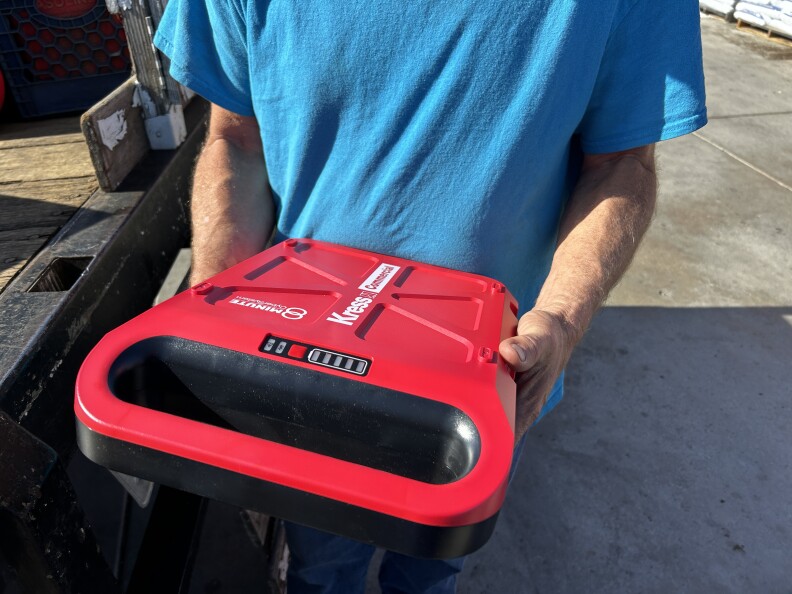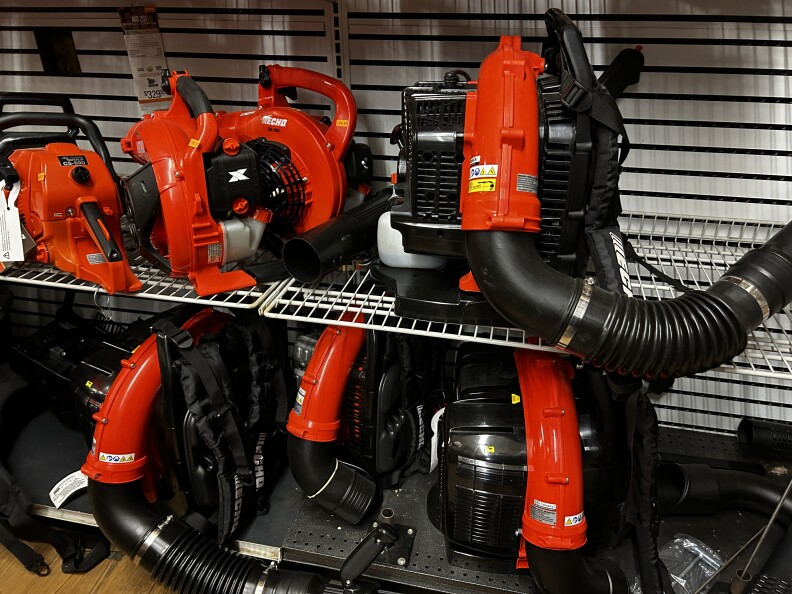Leaf Blower Bans Are A Win For Climate, But Small Businesses Are Struggling to Adapt

As the climate crisis escalates, more cities are doubling down on gas leaf blower bans. And the sound of electric leaf blowers — decibels lower — is in the air.
The amount of pollution these small machines create is significant:
- Using a gas leaf blower for just one hour spews the same amount of smog-forming pollution as driving a gas passenger car 1,100 miles, according to state data.
- Nationwide, a recent study found that lawn equipment alone — such as leaf blowers and lawn mowers — emit more planet-heating carbon dioxide than the entire city of L.A. does in a single year.
For decades, Southland cities have tried to nix gas leaf blowers. Beverly Hills has officially banned them since 1976. West Hollywood since 1986. Santa Monica since 1991. And L.A. since 1998.
-
Leaf blowers were available in the early 1970s, but their use skyrocketed in the 1980s. Not only were they a lot faster and easier than raking leaves, but at the time, to many homeowners, they were seen as a more environmentally-friendly option during drought years — instead of using hose water, homeowners used a leaf blower to clear their porches and driveways.
-
But as their popularity grew, the noisy and smelly leaf blower also became a nuisance to many. Their effect on air pollution was also becoming more apparent — so in 1990, California enacted a first-in-world policy requiring manufacturers to lower emissions from these machines. That policy was later enforced nationwide.
-
Through the 1990s, 2000s and 2010s, gas leaf blower technology got quieter and less polluting. More electric leaf blowers entered the market. But even with those efforts, electric never overcame gas in popularity for residents and businesses. Today, gas leaf blowers remain significant polluters: using a gas leaf blower for just one hour is equivalent to driving a new gas car about 1,100 miles — as far as it is to drive from L.A. to Denver.
Enforcing leaf blower bans
Pasadena’s ban on gas leaf blowers went into effect in April — and it's one of the few cities doubling down on enforcing it. Since the ban went into effect, the city has seen monthly complaints about leaf blowers double. City inspectors have issued citations for as much as $200 to gardeners who haven’t switched to electric.

The city first issues a 30-day warning to get into compliance, then there are escalating fines of $100, $200, and $500. The fourth and highest citation is $1000. If gardeners can provide documents that they’ve purchased equipment, but haven’t received it yet, they won’t be fined, according to the city.
“We believe that enforcement of this ban will improve our air quality, public health and also address issues with respect to noise pollution, which is one of the chief complaints we receive with respect to these leaf blowers,” said Israel Del Toro, the deputy director of Pasadena’s Planning and Community Development Department.
The city has conducted several workshops for local landscapers to test out equipment and learn about the law, but for many small business owners, the mandate is hurting their business and pushing others out of the industry altogether.
“We’re trying to survive”
Florencio Molina has run his gardening business for 30 years. He recently purchased an electric leaf blower because he has a couple of clients in Pasadena. He said the battery technology at this point can’t keep up with the pace and hours of the work.
“It's good for like two hours, so if you don't have a second battery, you're not going to finish your jobs,” Molina said.
Molina was able to purchase an extra battery. But he said another issue is those batteries are really heavy. Just like electric cars, electric leaf blowers can be more than twice as heavy as gas ones — a big lift for someone on their feet all day.
“We get more tired using electric,” Molina said. “It will affect our business.”
Still, Molina added, there’s always a tradeoff.
“It will affect our body,” he said. “For the future, you're protecting your lungs.”
At 63 years old, Molina said he’s close to retiring anyway, so his younger protégé will have to deal with the changes brought by electrification.

But landscaper Luis Rodriguez said he’s considering leaving the business altogether. He was recently issued a warning for using a gas leaf blower in Pasadena, which is why he was buying a brand new electric one when I met him.
“We’re not making a lot of money in this business,” Rodriguez said. “We’re trying to survive. And now, they are pushing us to quit this job.”
We’re trying to survive. And now, they are pushing us to quit this job.
Electric leaf blowers can cost four times as much as gas ones — upwards of $2,600 for the most powerful commercial models, as opposed to about $600 for gas.
Rodriguez said a few of his clients have helped him purchase electric equipment. But since most of his clients are in the city, and with the technology as it currently stands, he’d need to purchase an extra battery or several, which are the most expensive part of an electric kit.
Those costs are a big part of why, at 55, he’s considering closing his landscaping business and moving into another industry.
“I was thinking just leave Pasadena first, and then find another job, maybe work for a company,” he said. “Why don’t they go with the big business? They go with us first. All the time they go with the poor people first.”

Funding to help small businesses transition
The state launched a program last year offering vouchers of up to $400 to help small businesses purchase electric equipment, but after providing vouchers for more than 62,000 pieces of electric lawn and garden tools, the program — which started with $27 million in the pot — has already run out of funding.
-
At magnitude 7.2, buildings collapsed
-
Now spinning in front of Santa Monica apartments
-
Advocates seek end to new LAUSD location policy
The South Coast Air Quality Management District also has a voucher program, partially funded by the state, that covers up to 85% of the cost of commercial landscape equipment. That program, which is also available to local governments, schools, and nonprofits, requires landscapers to turn in their gas-powered tool. (The agency also has a rebate program for residents to buy electric lawn mowers).
That program’s funding opened in March 2023 with $4.6 million available. Now there’s $3.4 million left, which is meant to last through 2034, though the agency plans to work to find additional funding if the money runs out before then.
“That incentive approach combined with regulation will be necessary for an equitable transition to cleaner technology,” Kim White, a spokesperson for the agency, said in a statement to LAist.
-
- The South Coast Air Quality Management District, or SCAQMD, offers vouchers that cover up to 85% of the cost of electric equipment for commercial landscapers. Learn more here.
-
- SCAQMD also offers rebates for homeowners to purchase electric lawn mowers. Learn more here.
-
- The California CORE program may replenish funding for its voucher program for electric landscaping equipment in the future. You can stay up to date and learn more here.
Outsize burden on the “little guy”
Alvaro Huerta, an associate professor at Cal Poly Pomona, helped organize the Association of Latin American Gardeners of Los Angeles in the mid-1990s to fight L.A.’s ban on leaf blowers back then. While that fight was largely about the jail sentence that came with L.A.’s original proposed ban (there’s no jail sentence for noncompliance anymore, thanks to the organization’s efforts), Huerta said the current approach has a disproportionate impact on largely Latino small businesses, workers and immigrants.

“This is something that we were arguing in 1996, that they should go after the manufacturers,” Huerta said. “Why are you attacking the little guy? I do believe that they need to be phased out because I am an environmentalist. However, they should be phased out just like cars are being phased out, in a more realistic time frame. The way they're doing it is they're banning them now, and they're punishing them now.”
California’s phase out plan for the trucking industry does allow smaller companies to have more time to transition. As for lawn equipment, in 1990 the state became the first in the world to incentivize lawn equipment manufacturers to create cleaner products. That policy was later enforced nationwide and has helped reduce pollution from these machines significantly.
But the technology (and cost) hasn’t improved enough for commercial landscapers to choose electric over gas, and levels of pollution from them still haven’t fallen — pound for pound — as much as pollution from cars and trucks. In fact, as more people switch to electric cars, the state expects pollution from small lawn and garden equipment to be double the pollution from light-duty passenger cars by 2031.

That’s why a statewide law banning the sale of new gas-powered lawn and other small outdoor equipment goes into effect in January, a further incentive for manufacturers that will likely impact the entire nation, as California’s clean car rules have in the past.
A changing lawn equipment industry

For the vendors that sell this lawn equipment, the story’s a little different. Charles Kim helps run his family’s long-time business Lawn Mower Corner in Pasadena. He said 2023 has been a great year for sales because of the electric leaf blower mandates.
“But we look at it as a short term gain, with a long term pain,” Kim said.
He noted that about 40% of their business right now is maintaining older gas equipment, such as changing oil and cleaning carburetors. Electric equipment, on the other hand, requires very little, if any, ongoing maintenance.
He said to adapt, the store is diversifying the type of products they sell. For example, they’re expanding from largely commercial equipment to other types of lawn and garden supplies.
“That's what we had to do to not put our eggs in one basket,” Kim said.
And for now, he said they’re stockpiling gas equipment to sell into the new year because the statewide rule banning the sale of all new gas-powered lawn equipment goes into effect in January.
-
The state's parks department is working with stakeholders, including the military, to rebuild the San Onofre road, but no timeline has been given.
-
Built in 1951, the glass-walled chapel is one of L.A.’s few national historic landmarks. This isn’t the first time it has been damaged by landslides.
-
The climate crisis is destabilizing cliffs and making landslides more likely, an expert says.
-
Lifei Huang, 22, went missing near Mt. Baldy on Feb. 4 as the first of two atmospheric rivers was bearing down on the region.
-
Since 2021, volunteers have been planting Joshua tree seedlings in the Mojave Desert burn scar. The next session is slated for later this Spring, according to the National Park Service. Just like previous times, a few camels will be tagging along.
-
There are three main meteorological reasons why L.A. is so smoggy — all of which are affected when a rainstorm passes through and brings clearer skies.






